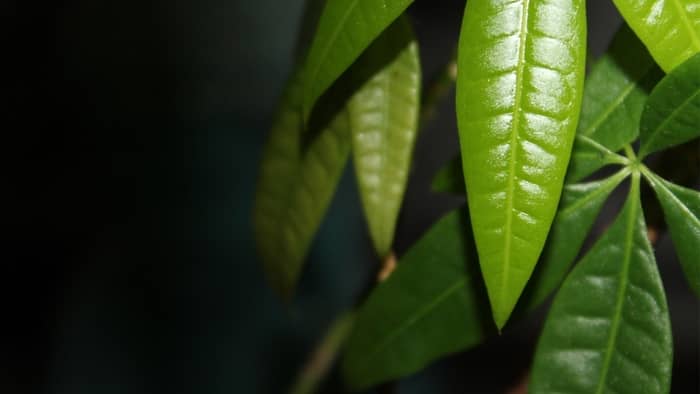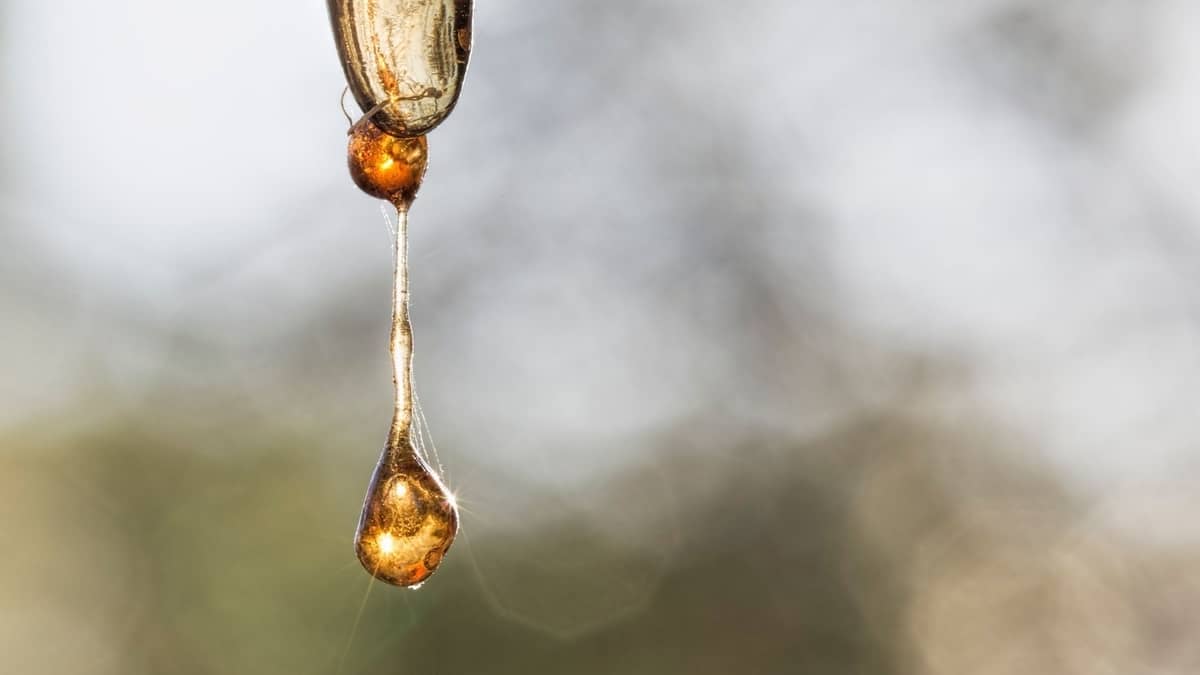Last Updated on September 3, 2022 by Griselda M.
Under certain conditions, your money tree plant, Pachira Aquatica, can develop sap-covered, or moist leaves. Sometimes this can be a symptom of pest problems, and sometimes it is a natural process. Read more to find out about Money tree sap, and how to live with it.
What is a Money Tree?
Before we go too far down this path, let’s make sure we are all talking about the same plant. A Money Tree typically is a common name for Pachira Aquatica. This plant has a relatively easy-to-bend stem, meaning that if you plant a few small plants in the same pot you can braid the stem together – which some people find attractive.
Personally, for me, if I wanted a rope I would plant a rope, and I like my plants to look natural. Plants that look like a rope are not realistic.
What is a money tree sap?
Guttation
This is the simplest and least worrying form of money tree sap. Guttation is a plant’s equivalent of sweating. Plants do this for various reasons but it happens mostly at night.
Typically, at night, a bit of pressure can build up in the roots, and this causes water to flow to the leaves – however, because it is nighttime, the stomata in the leaves are closed, so no evapotranspiration occurs. The result is that the plant releases pressure through hydathodes – special cells at the tip of the leaves. This results in little droplets forming on the leaves.
This is generally harmless, but for me, if I see it on a money tree, I work on the assumption that I have overwatered my plant slightly, and will reduce watering.
Insect problems
Various pests such as scale, aphids, woolly aphids, whitefly, and mealybugs can become a problem on your plant. These all exude a sticky excretion rich in sugars that causes fungus to grow. If you do not keep an eye on these pests they can damage or kill your plant quite quickly. My first choice is always neem spray.
I am never an advocate of chemical pesticides on edible plants – however, for inedible plants (well probably poisonous actually) such as a money tree, if you have a recurring pest problem you could try a systemic pesticide that contains imidacloprid.
This will control your pests quite effectively, but generally, if your plant is getting pests, it is not healthy so look at getting it a bit more light to make it stronger as well.

What Money Tree Sap is Good For?
Everything I can find suggests that it is either poisonous or not poisonous. This is the danger of the internet. People copy each other, and block and paste articles.
This is why the best source of data is peer-reviewed data, that is published scientifically. At least here, if somebody writes complete garbage and gets caught there is some sort of consequence.
I went and searched PubMed, and found that there is some evidence to suggest that there are beneficial compounds in the nuts, that can be included in the food. This paper suggests that there are chemicals in the stem (I assume this is in sap) that can be useful as antioxidants, specifically mediating certain reactions where types of white blood cells can get a bit ahead of themselves. This paper basically showed that in animal (rat) and insect(fruit fly) model animals little evidence of harm from the consumption of money tree extracts was detected.
There are also reports that I can find in some FAO documents that suggest that extracts from the stem and leaves can be used for treating hepatitis. Some reports suggest that the seeds can be used to make flour, and others suggest it is an anesthetic. Some suggest that it kills rats, others that rats show no effects at all after consumption.
My observation here is that there is probably quite significant genetic diversity in the species, and probably considerable metabolic differentiation among different strains of this plant and that some may be non-toxic and others toxic.
In this regard, I would apply the precautionary principle and work on the assumption that the plant is toxic. I personally would not have anything to do with this plant other than to use it as a pretty decoration.
How Often Do You Need To Water Your Money Tree?
In summer keep the soil moist – in winter, do not overwater. I killed two of mine by over-watering in winter. Rather let the soil dry out completely and then water again. They drop their leaves in winter and don’t need much water. In spring the leaves appear, and the need for water increases.
Conclusion On Money Tree Sap!
If your money tree has wet leaves at night, this is guttation. Reduce watering. If it has wet leaves during the day, then it probably has an insect pest.
Apply neem oil. Money tree sap, as far as I can tell, appears to be something that is a high-risk thing to use as a medication. Rather avoid it.
If you can get a money tree from some sort of traditional healer, that knows what they are doing, this may be a different story, but for me, the risk and contradictions in the literature are too great for me to even consider any medicinal or culinary use of this plant.
FAQs
How to cure a money tree plant of sap?
Money trees produce moisture on their leaves at night by a process known as guttation - root water pressure builds up and causes water to leak out of hydathode pores in the leaf. Reduce watering, and this will reduce in intensity. If the plant has insect pests, it may produce sap during the day - spray the plant with neem. Reduce watering until it recovers.
Money tree sap under leaves
This can have two causes - guttation, or insect infestation. If it is guttation this is a process by which root water pressure vents through hydrathode cells in the leaves. Reduce watering and the severity will decrease. If the problem is from insects, and you can see the insects, kill them with neem oil spray.
Money tree plant care sap
I actually have no idea what you searched for here! Lets work on the assumption you are worried about money tree sap and want to care for your plant. Guttation is a natural process by which an overwatered plant will exude a few drops of liquid from its leaves. Reduce watering. If you see insects on your plant, they can cause honeydew (leaf sap mixed with insect poop) to leak onto your leaves and floor. Kill the insects with neem oil.
Branko is the world‘s most enthusiastic gardener! He is always on the hunt for the perfect flower, bush or tree to add to his ever–growing garden. He is known for his love of all things green, and his passion for nurturing the plants he grows is unmatched. He loves to get his hands dirty and can often be found humbly tending to his garden at all hours of the day. Branko is the go–to guy when it comes to gardening advice – he is always happy to share his knowledge and wisdom with anyone who will listen. He also loves to play pranks on unsuspecting visitors, so beware if you enter his garden!




